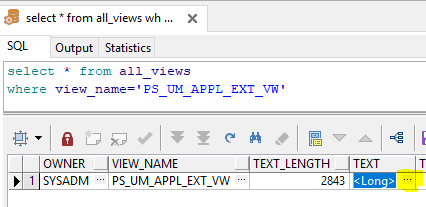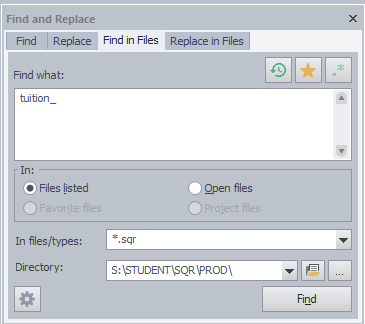Table or views are built in various ways, so finding the data sources can be challenging.
- SQL Code:
All views are based on SQL code. Use all_views function to look at the SQL code. - SQR:
CS: The SQR code is located in S:\STUDENT\SQR\PROD for some tables. Not every table was made by SQR, but here are the samples. The SQR file name should start with 'um'.
- umappext.sqr for UM_APPL_EXTRACT - Applicant Reporting Extract
- umstuarc.sqr for UM_STUD_EXT_ARC - Student Reporting Extract Arch
- umstuext.sqr for UM_STUD_EXTRACT - Student Reporting Extract
FIN: The SQR code is located in S:\FIN\SQR\Prod.
- umglrex.sqr for UM_GLQ_REPRTING - Ledger Data
- umglacta.sqr for UM_GLQ_ACCTA - GL reporting account attribute
HR: The SQR code is located in S:\HRMS\SQR\Prod
- (Not sure)
- Application Engine Program:
- PeopleCode:
Find a certain field in SQR:
- Open UltraEdit
- Go to Home> find/replace in files > Find in files
- Enter field you are looking for, file type (*.SQR), and directory
- Click Find
Here are useful tables in PL/SQL Developer when you search for tables, views, fields or data source. Log in PL/SQL Developer in the environment you want to be and explore them.
all_tables
- select * from all_tables gives the list of all tables available in the database
all_views
select * from all_views gives the list of all tables/ views available in the database.
Click '... ' under 'TEXT' field for the view you want to see. The pop-up window shows all fields in the view and the table(s) that the view is based on.
psrecdefn
- select * from sysadm.psrecdefn gives the short description of table/view, field count, etc. for each table or view. The LASTUPDDTTM is the date that the query was last run.
psrecfield
- psrecfield is useful when you know the field name and want to know which table it is used.
For example, you want to know the table name that contains 'CRSE_ATTR' in the field name. The SQL below gives the list of all tables whose fieldname includes 'CRSE_ATTR'.
select * from sysadm.psrecfield
where fieldname like '%CRSE_ATTR%'
ps_um_psqrydfn_sql (For CS and HR only.)
ps_um_psqrydfn_sql has PS query information. You can do the similar search in PL/SQL Developer when you use 'Advance Search' on PS Query Manager.
- Example 1: If you want to get a list of queries start with "UMS_DTS", the SQL below gives the list.
select * from sysadm.ps_um_psqrydfn_sql
where qryname like 'UMS_DTS%'
- Example 2: If you want to get a list of queries that was created by you, the SQL below gives the list.
select * from sysadm.ps_um_psqrydfn_sql
where createoprid='(your id)'
- Example 3: If you want to get a list of queries that has 'ACAD_PLAN' field, the SQL below gives the list.
select * from sysadm.ps_um_psqrydfn_sql
where sqltext like '%ACAD_PLAN%'
- Example 4: If you want to get a list of queries that has certain table or view (UM_STUD_CENS_VW, for instance), the SQL below gives the list and click '... ' under 'UM_DESCR_LONG' field for the query you want to see. The pop-up window shows the list of all tables or views that was used in the query. Also see CLOB Large Data Fields - Retrieving The Data.
select o.oprdefndesc, q.* from sysadm.ps_um_psqrydfn_sql q
left join sysadm.psoprdefn o on q.oprid=o.oprid
where um_descr_long like '%UM_STUD_CENS_VW%'
psqryexpr (For Finance)
We can get PS query information by joining this table to psqrydefn.
- Example 1: If you want to get a list of queries that is use /*-BASE_BUDGET (expression for BASE_BUDGET based on Discoverer SQL) , the SQL below gives the list.
select * from sysadm.psqrydefn s
left join sysadm.psqryexpr p on (p.qryname = s.qryname )
where dbms_lob.instr(p.expressiontext, '/*-BASE_BUDGET') > 0
pspnlfield
To find page data, use Control -J on PeopleSoft page. This query will provide more information of the page data.
select * from sysadm.pspnlfield
where PNLNAME='UM_PRAXPASSED_INFO' ← enter page name for PNLNAME
RECNAME on pspnlfield is the table or view name of the field


